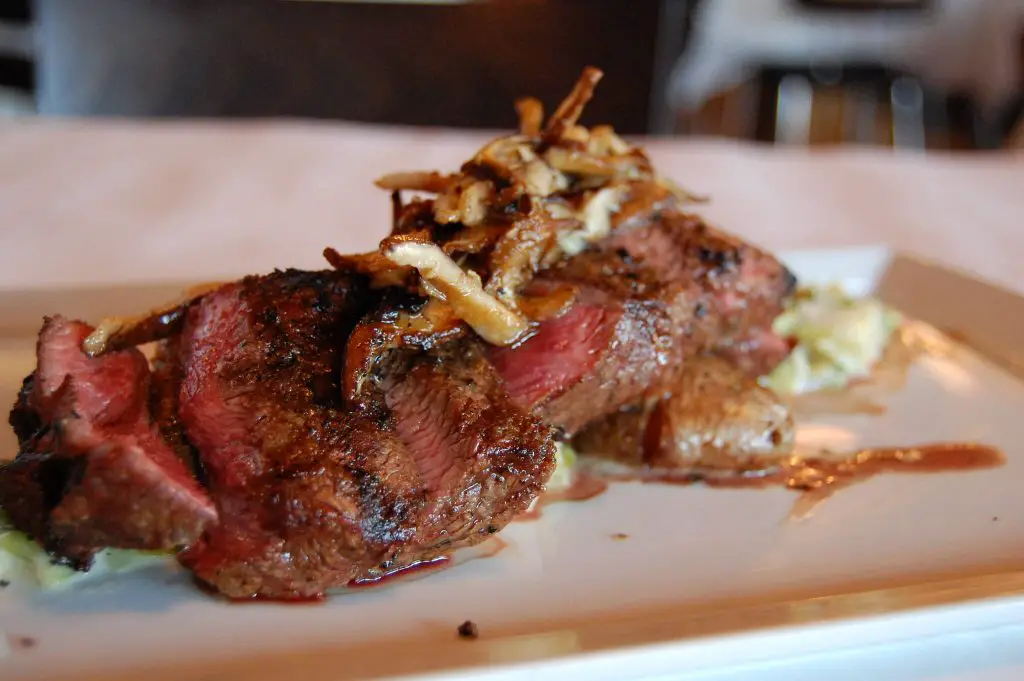If you’re a regular reader here, then you’ll know that the amount of steak cuts cropping up is only increasing over time.
In this post, we answer, what is blade steak? And go through everything you need to know about this cut.
In short, blade steak is a cut from the chuck section of a beef animal.
Blade steak is often braised and sliced thinly against the grain before serving, as this cut tends to be quite tough and stringy. It can also be marinated for added tenderness.
Let’s take a closer look…
Contents
What Exactly Is Blade Steak?
Blade steak is a cut from the chuck section of a cow.
The chuck is the shoulder region of a cattle, which means that blade steak has taken its name from this section of the cow’s body.
This cut originates from the ribs 6 through 9.
On average, blade steak is approximately three inches thick and 2.5 to 5 pounds in weight.
Otherwise known as top blade roast, flatiron steak, or shoulder petite tender, blade steak is actually a cut of beef used frequently in Korean cuisine.
It can be thinly marinated before being placed on a hot grill.
In the United States, however, blade steak is most commonly used as a substitute for more expensive cuts of meat such as tenderloin or rib-eye.
It’s typically touted as a flavorful alternative that won’t break the bank.
Though this cut of meat is leaner than many others due to its lack of exterior fat and connective tissues, it may contain a small muscle separated from the main cut called “chine bone.”
While most people who encounter this problem will simply remove the portion of meat containing the bone, others may experience difficulty due to its close proximity to the blade steak.
Though many agree that such an obstacle doesn’t necessarily ruin the meat, they may find that cooking is more difficult with this in place.
It’s typically used in stews and braised dishes such as Swiss steak because it tends to become dry when cooked for extended periods of time on its own.
Blade steak has a rich history dating back to the 19th century when the city of Chicago was an active player in the meatpacking industry.
Heralded as “the city that made the American steakhouse,” Chicago became a center for beef by positioning itself between quality grain-producing farmland and major cities.
Blade steak’s close proximity to the cow’s shoulder blade has led some people to refer to it as the “poor man’s porterhouse.”
Although it’s not as tender as a porterhouse, the flavor of blade steak is similar and has its own unique appeal that some people find quite enjoyable.
How Is Blade Steak Best Cooked?
When it comes to cooking blade steak, it’s best cooked with high heat using methods like searing, pan-frying, or grilling.
Blade is also commonly used in slow-cooking dishes like stews or braised dishes to produce a tender product that melts in your mouth.
This steak is easy to cook and only requires a few minutes to cook on each side.
You can heat a cast iron skillet to medium-high heat and pour a bit of oil into the pan to give the blade steak a nice sear before you place your steak into a preheated oven at 350 degrees F.
Then simply bake for about 15 minutes, flip the steak over and bake it for another 15 minutes.
This will allow the blade to cook through while also cooking off any excess marinade that’s clinging to your meat.
Then take your steak out of the oven and let it rest for 5 minutes before slicing
Cooking blade steak below medium-rare will result in a more tough and chewy steak.
This is why it’s important to ensure your steak is cooked correctly and to avoid cooking it too long as this can give the same effect.
The blade steak has beef tenderloin running through it within the steak that provides amazing flavor and juiciness.
How Is Blade Steak Best Prepared?
When it comes to preparing blade steak, it doesn’t take much time.
This steak works perfectly with any marinade, but it’s especially tasty when doused in something rich and flavorful.
Ensure you season with salt and pepper and use any spices you desire.
After marinating, sear the steak on both sides in a large frying pan or skillet to lock in the juices.
You can also grill your blade steak if desired, but it’s important not to overcook this cut of meat on either method of cooking.
How Is Blade Steak Best Served?
When serving blade steak, in my opinion, it’s best to serve with a rich, red wine sauce.
It’s also delicious with a zesty chimichurri or horseradish cream sauce.
If you’re looking to keep things light and simple, serve it with grilled vegetables and rice pilaf.
Potatoes or fries are also a great side for this steak, and so is a salad.
Is Blade Steak Expensive?
When it comes to the price of blade steak, it’s not very expensive.
You can get it at your local grocery store for about $5 to $10 per pound.
It’s well worth the price, in my opinion!
The price of this cut is going to depend on where you buy the steak from, but I recommend keeping an eye on the discounted section of your local supermarket or ask your local butcher.
In today’s modern world you can even buy blade steak online if you desire and have it delivered straight to your door.
Where Is Blade Steak Commonly Found?
Blade steak is can found in the United States, Australia, UK, and New Zealand, and others.
It’s a cut of meat that can be found in many supermarkets, grocery stores, and butcher shops around the world.
I’ve found this steak in several different supermarket chains throughout my state and also in butcher shops.
What Is The Nutritional Value Of Blade Steak?
If you’re keen to try this cut, you’ll be glad to know that the nutritional value of blade steak is not too shabby!
Blade steak is naturally low in both cholesterol and fat, so even if you’re on a diet it won’t be hard to fit this cut into your meal plan.
The cut is full of protein as well, and as such is a great option for those who like to work out.
See below the nutritional value of one serving (100g) of Blade Steak below;
- Calories =177
- Fat = 6g
- Saturated Fat = 2g
- Carbohydrates = 0g
- Sugars = 0g
- Protein = 30g
As you can see, this cut is very high in protein and has little fat too, making it a great choice for those who are fitness conscious.
As well as this, blade steak contains a good amount of iron, which is essential in the production of red blood cells.
These help to carry oxygen around your body and are also used to make up muscles!
The nutritional breakdown of blade steak is pretty strong and holds up well when compared to other cuts such as rib-eye or sirloin.
As you can see, blade steak has a lot going for it nutritionally and is worth considering if you’re looking to reduce the number of saturated fats that you eat during your day.
Other Considerations
It’s worth keeping in mind that blade steak is a tough cut of meat, and without a close eye being paid to it when cooking may come out chewy or dry if not properly treated.
Using a slow cooker or braising it in liquid is the best way to avoid this problem.
Other than this, blade steak is perfect for just about any cooking method including grilling, frying and pan-frying just to name a few.
Other names for blade steak include top blade steak, and flat iron steak, depending on your geographical location.
Another consideration for blade steak is that it’s often not as tender as other cuts of meat.
This means it requires special attention and care, and should only be cooked to rare or medium-rare to avoid having a tough or rubbery texture.
The trick is marinating your blade steak overnight in a liquid that includes an acid such as lemon juice.
Once the blade steak has marinated, it only takes a short period of time to cook.
Conclusion
In conclusion, blade steak is a beautiful cut that can be enjoyed as part of a healthy and nutritious diet.
This cut is easy to cook and doesn’t take much preparation at all, so it’s a great choice for busy people who still want to eat right.
It’s packed full of protein so is perfect for fitness fanatics.
Next time you see this cut in a supermarket or restaurant don’t be afraid to give it a try, I’m confident that you won’t be disappointed.
Thanks for taking the time to read this post, you’re a real trooper! I really hope that you’ve learned something new about blade steak.
If you have, then why not share the article with your friends and family? That way they can also learn something new too.

